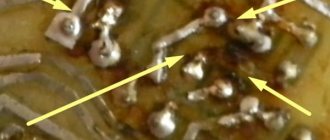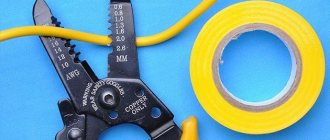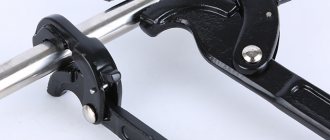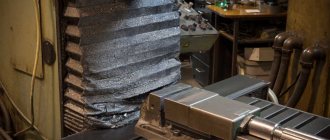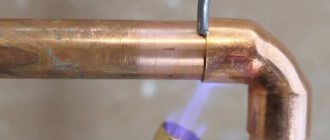A soldering iron is an indispensable tool for minor repairs of electrical appliances. Before purchasing this device, many amateur craftsmen wonder how to choose a suitable soldering iron: reliable and not too expensive. In our Top 8 best soldering irons, we have collected the most successful models for home and professional use, suitable for soldering printed circuit boards and radio components, tinning and other tasks. To begin with, let’s decide what and how to choose.
- How to choose the best soldering iron
- What to look for when buying a soldering iron?
- Top 8 best soldering irons
- FAQ
How to choose the best soldering iron
Types of soldering irons and their features
A soldering iron is a device used to heat parts, melt solder and apply it to the contact point of elements that need to be soldered. There are several types of soldering irons, differing in the method of heating the metal tip (tip):
- Electric , the working surface of which is heated using electric current. This is the most popular type of device among both amateur craftsmen and professionals.
- Arc , heated by an electric arc located between the electrode and the tip.
- The socket and hammer handles differ in appearance by having rather long metal handles, at the ends of which tips are attached. Such soldering irons are heated by external heat sources.
- Hot air devices are used for soldering parts with hot air.
- An infrared soldering iron connects elements in a non-contact manner. The operating principle of the device is based on exposing the part to infrared radiation with a wavelength of 2-7 microns.
- The gas apparatus consists of a torch with an installed soldering tip and a gas cylinder. Soldering with a gas soldering iron can only be done with air heated from the burner, without using a tip.
The most convenient and effective devices for soldering metal and plastic parts are electric soldering irons. Electric soldering irons from German and Japanese manufacturers are considered the highest quality. Among them are brands such as Goot, Weller, Matrix, Hakko, Ersa.
Soldering Station
In addition to the soldering iron, you can purchase a hot air soldering station. This is a powerful tool in the hands of a radio amateur. This tool is equipped with temperature settings accurate to one degree. The soldering station has a convenient stand. Using such a device, you can solder not only small radio components, but also desolder entire microcircuits from boards using hot air.
It will be interesting➡ The design of an ammeter and the principle of its operation
Soldering stations can significantly speed up your work. But to solder with such a station, experience is required. For beginners, there is no need for a soldering station at first. A simple soldering iron is enough to learn soldering skills. But once you get comfortable and confidently hold a soldering iron in your hand, you can think about more expensive equipment.
Soldering Station
What to look for when buying a soldering iron?
The design of most electric soldering irons is identical. They consist of a heating element with a transformer winding inserted into a shell of insulating material, and a handle made of wood or plastic. The working tip (tip) is designed to quickly transfer heat from the source to the part being soldered. In its manufacture, red copper is used, which can withstand high temperatures well.
Electric soldering iron power
Power is the most important characteristic of the device, taken into account when selecting a specific model of the device, since the heating temperature of the working surface directly depends on it. To solder elements of small microcircuits, we recommend purchasing a soldering iron whose power does not exceed 25 W. If you use a more powerful device, you can damage the microcircuit. It is better to solder thick wires with a soldering iron with a power of 40 W.
Tip material and shape
In order for the device to serve for a long time and the soldering of parts to be of high quality, the working tip must have high thermal conductivity, the ability to accumulate heat, wear resistance and a protective oxidative film.
Copper alloys are considered the most suitable material for working tips. However, they have low wear resistance and are susceptible to corrosion. Steel and nickel alloys are quite strong and corrosion-resistant, but have very low thermal conductivity. Taking these factors into account, modern manufacturers use various composite materials to make tips.
Some models use a copper tip coated with nickel. Such tips last quite a long time, but have a low adhesion rate. This is a significant drawback, since molten solder does not stick to the tip. Copper tips with silver coating are a little more expensive, but do not create such problems for the master.
Recently, manufacturers have been installing ceramic-coated metal tips on electric soldering irons. They are characterized by high thermal conductivity, heat capacity and are not subject to corrosion. When working with such a tool, there is no need to constantly clean the tip.
Tips for soldering irons are produced in the form of a needle, cone or wedge. The most convenient is considered to be a wedge-shaped tip, which can be used for various jobs. It heats up faster than others and holds solder well.
Temperature controller
A significant advantage of modern soldering irons is the presence of a temperature regulator, which is convenient to use when frequently changing soldering modes. They are more expensive than regular ones, but if necessary they can replace several devices. Reducing the temperature is advisable when working with thin wires that may become damaged. With such devices it is convenient to work with complex devices and microcircuits that require soldering parts of various thicknesses.
Handle material
The handle of an electric soldering iron is made of a material that can withstand high temperatures. Wood is considered the most suitable for these purposes. Soldering irons with wooden handles are quite lightweight and do not deteriorate when heated. Models with ebonite handles are very heavy and cause inconvenience when working, and those with plastic handles often overheat.
Characteristics
Technical characteristics that you should pay attention to when choosing a tool:
- Power. In the case of soldering irons for circuits, the power value should not exceed 10 W. This parameter affects the performance and safety of electrical elements. This approach is used when installing a circuit. If elements are being removed from the board and their safety is not important, then a high power value will facilitate the process.
Powerful devices can only be used by experienced radio amateurs who are able to perform work accurately and quickly without causing overheating of the elements.
Devices of various power
- The voltage required to operate. High voltage from the network, equal to 220 V, can also damage parts. For this reason, the soldering iron is connected through a step-down transformer, which, depending on the model, produces either 12 or 36 V. When choosing a product, it is best to take a kit that already includes a transformer or power supply, so as not to purchase it separately.
- The thickness of the tip also plays an important role. For conventional instruments it is about 5 mm. For micro-soldering tools, a value of up to 3 mm is considered normal. Replacement tips are most often sold separately, but there are kits that also include them.
- Soldering tool
- Along with a soldering iron, it is a good idea to purchase various accessories and tools. If you once worked with a good tool, then you are unlikely to want to work with a bad one. Therefore, it is better to buy a good tool once than to buy a bad one several times.
- For soldering you will need the following tools:
- – small wire cutters – for wires, parts leads and stripping of insulation,
- – file – for cleaning the soldering iron tip,
- - tweezers - so as not to burn your fingers,
- – medical scalpel or stationery knife,
- – a syringe needle with a blunt tip,
- - thin awl.
- As you gain experience in repairing and manufacturing electronic circuits, this arsenal of yours will gradually expand and modify.
- How to organize a soldering workspace
- A good workshop, and especially a set of tools, takes years to create. Moreover, when mastery comes, purchased instruments no longer meet our requirements; we have to make instruments with our own hands. But for this you need to have not only a workplace, but also the appropriate equipment.
- A workshop is needed not only for working with electronic devices and structures, but also for general household work. Modern apartments, as a rule, do not leave us the opportunity to equip our workplace in a separate room, so we can use any free corner. Attaching shelves to the wall, planning the corner and lower cabinet is a matter of your imagination and skill.
- To place the tool, you can use strips with permanent magnets or a homemade set of magnetic door latches. On the surface of the table, equip a special field covered with asbestos - for working with a soldering iron, acids and solvents.
- For particularly small parts for one purpose, use plastic boxes for cacti, glued (fastened) into a typesetting box. Or buy special containers at a specialty store. For medium-sized parts, rectangular sour cream boxes are well suited; they have very comfortable sides that fit well into specially cut grooves. Microchips, in addition to standard plastic boxes, can be conveniently stored in sheets of foam inserted into a shoe box.
- The cabinets at the top and bottom can accommodate spare parts, an electric drill (small drilling machine), LATR, various files, a jigsaw, a small hand drill, various containers with varnishes, adhesives, solvents and ferric chloride. Set aside a special place for measuring instruments, place separately a small vice with an anvil, a large vice, etc.
- Make sure to have a container with low sides and a large enough area for debris - bitten off leads and removed braiding. A plastic disposable plate is very suitable for such waste (do not touch it with the tip of a heated soldering iron!).
- Power supply and lighting of the workplace
- It is imperative to provide local lighting for the workplace. Previously, we published an article on our website with instructions for making a powerful table lamp. See: DIY Timeless Table Lamp. This lamp is ideal for performing small jobs with a lot of eye strain.
- The light should fall on the board so that the hand with the soldering iron does not cover it. The power supply panel in the laboratory must provide: adjustable direct voltage (rectified) and alternating voltage 0 - 250 V (LATR), power for the soldering iron and any necessary direct current voltage to power any electronic structures.
Gas soldering iron
Top 8 best soldering irons
The best soldering iron for home
Union PS2005-40
Used for soldering wires and various radio components. The model has a simple configuration and does not have a temperature switch. Device power – 40 W. It operates from a mains voltage of 220 V. The operating temperature of the tip allows the solder to melt well and transfer it to the desired area of the part. The device has a wooden handle and a cone-shaped tip that maintains the temperature for a long time. As the tip wears out, it must be replaced with a new one.
Price: ₽ 133
The best professional soldering irons
Bison Professional 40W 55413-40
A domestically produced device with a power of 40 W can be used to install various elements on the surface of a printed circuit board. The soldering iron has a cone-shaped tip and a two-piece, durable handle. Its handle shape is designed in such a way that the device can be held in the hand for a long time. The electrical cord is long enough to eliminate the need to work directly near an outlet. The kit includes a cap that protects the working part of the soldering iron from damage during storage. The disadvantage of the device is the lack of a temperature switch.
Price: ₽ 694
Bison Expert 60W 55402-60-z01
Considered the best electric soldering iron for working with printed circuit boards. Soldering of conductors and other components is carried out using flux or a lead-tin alloy used as solder. The two-component handle of the device has a special shape designed for long-term use. All structural elements of the soldering iron are made of high-quality materials, which guarantees a long service life of the device. Device power – 60 W. The working cone-shaped copper tip has a special coating that allows soldering to be performed quickly and efficiently. The soldering iron comes with a special stand, a protective cap and solder.
Price: ₽ 804
Best portable soldering iron
STAYER PROFESSIONAL 55409
Designed for soldering wires and small parts. Despite the low power of the device (8 W), the soldering quality is very good. This cordless soldering iron requires only three AA alkaline batteries to operate. The model has a lightweight body and heats up and cools down quickly. The soldering iron comes with a nozzle, stand and solder.
Price: ₽ 692
Best hammer soldering iron
Bison Professional 200W 55301-200
With a power of 200 W, it is designed for soldering and tinning large metal elements. It is advisable to use it for work in various types of industry. The soldering iron has a high-strength ceramic tip. The handle of the device is comfortable to hold in your hand. The high quality of materials from which the soldering iron is made ensures a long service life with constant use. For ease of use, there is a shutdown button on the device body. Protection from electric current when working with the device in case of damage to the insulating sections is provided by a grounding wire.
Price: ₽ 1,482
Best ceramic soldering iron
Rexant 220V 25W 12-0121-1
With a power of 25 W, it is used for manual soldering of radio elements. The device has a ceramic tip, characterized by fast heating and long service life. To ensure high-quality tinning, the surface of the working area of the tip is coated with tin. The handle of the device is made of heat-resistant plastic. For ease of use, it is equipped with rubber elements.
Price: ₽ 335
The best pulse soldering iron
Rexant 220V 30-70W 12-0161
With a power of 70 W, it allows you to solder various radio components. The device is equipped with an operating mode switch (70 W and 30 W), it is a trigger, when pressed, the soldering iron starts working with maximum power. The soldering iron is designed in the form of a pistol with a comfortable plastic handle. There is a power indicator on the body of the soldering iron.
Price: ₽ 345
The best vacuum soldering iron with desoldering
Rexant HT-019 220V 40W 12-0171
Used for soldering radio components and cleaning the surface from solder. The device has a built-in vacuum pump that allows you to draw in particles of molten solder. Most often, a soldering iron is used to remove installed elements and excess solder from printed circuit boards. Impact-resistant plastic is used in the manufacture of the device handle. Thanks to this, the device holds firmly in the hand and does not slip.
Price: ₽ 388
Fluxes: basis for soldering in radio electronics
As a rule, a radio amateur has many different chemicals in his arsenal, which allows him to create the highest quality and reliable solder. Fluxes are special chemicals intended for radio installation. It allows you to remove oxide films and allows the solder to spread evenly. Fluxes are divided into several types: neutral, active and anti-corrosion.
Neutral fluxes
Neutral are the most popular, simple and safe fluxes. They do not contain acids or other aggressive elements that cause corrosion of metals, and generally do not require rinsing. Rosin, the cheapest type of flux, is a must-have for every radio amateur. It protects the surface from oxides and prevents corrosion. We can say that this is a universal type of flux.
LTI 120 is a liquid flux, classified as neutral. It contains no acids, which means it will not corrode metal. The basis of its composition is rosin dissolved in alcohol. LTI-120 is easy to use: you just need to apply a layer of flux to the surface to be soldered, and then solder the desired element to the board.
On sale you can also find gel fluxes based on rosin. They are very convenient for soldering when you only need to apply a small amount of flux to a specific area. Typically, neutral fluxes do not require rinsing, however, many hams prefer to rinse off any flux after use.
Active fluxes
Active (also called acid) fluxes contain hydrochloric, phosphoric or citric acid. After using them, it is necessary to wash the part, since flux residues will cause corrosion and corrode the soldering. These fluxes mainly remove aggressive substances from soldered parts.
The most popular flux of this type is soldering acid. It can be used to solder, for example, nickel alloys. F38N is used for soldering resistant corrosion steel, various copper alloys, bronze, nichrome and brass. Residues of F38N can be easily washed off with water.
Other types
There are also anti-corrosion fluxes consisting of phosphoric acid. They do not cause corrosion of ferrous metals, which means there is no need to remove flux residues after soldering. For non-ferrous metals, rinsing with warm water is recommended. In addition to water, fluxes can be washed off with acetone, nephrase, ethyl or isopropyl alcohol. All of these products are suitable for cleaning printed circuit boards.
There are also solder pastes, which are a mixture of flux and solder. It happens that such pasta is made independently. You just need to use a file to make shavings from solder and mix it with liquid fluxes. This paste can be applied to the part and then warmed up the soldering iron. It can be used when soldering surface-mounted installations or used in hard-to-reach places on the board.
Table of solders for soldering irons for microcircuits.
Interesting read: what is electric current?
Comparison table of the best soldering irons
| Name | Main characteristics | Price |
| Union PS2005-40 | Simple configuration, device power – 40 W, operates from a network with a voltage of 220 V. | ₽ 133 |
| Bison Professional 40W | The power is 40 W, there is a cone-shaped tip and a two-component durable handle, and a cap is included. | ₽ 694 |
| Bison Expert 60W | The power of the device is 60 W, the kit includes a special stand, a protective cap and solder. | ₽ 804 |
| STAYER PROFESSIONAL 55409 | Power - 8 W, the soldering iron comes with a nozzle, stand and solder. | ₽ 692 |
| Bison Professional 200W | Power - 200 W, there is a shutdown button. | ₽ 1 482 |
| Rexant 220V 25W | Power - 25 W, has a ceramic tip, the handle is made of heat-resistant plastic. | ₽ 335 |
| Rexant 220V 30-70W | Power - 70 W, there is a switch for operating modes (70 W and 30 W). | ₽ 345 |
| Rexant HT-019 220V 40W | There is a built-in vacuum pump, shock-resistant plastic is used, and is non-slip. | ₽ 388 |
Price overview
To summarize, let's consider the price level in various localities of the Russian Federation and the CIS for the 40-watt model of the ZD-200C soldering iron.
| Locality | $ | Locality | $ |
| Moscow | 6,00 | St. Petersburg | 6,00 |
| Donetsk | 6,50 | Kazan | 6,40 |
| Minsk | 6,20 | Odessa | 6,20 |
| Kharkiv | 6,10 | Vladivostok | 6,35 |
The table shows that the price of a soldering iron for microcircuits in Russia is practically no different from its cost in Minsk, Kharkov or Odessa.
FAQ
Is it possible to solder lead with a soldering iron? Soldering parts made of lead is rarely done, since the connection turns out to be fragile, even if you use liquid flux.
Which is better: a soldering iron or a glue gun? To fasten elements made of metal and plastic, it is preferable to use a soldering iron, since the connection is more durable.
How to protect a soldering iron from overheating? For this purpose, you can use a stand with a contact that opens the jumper. When the device is removed, the diode connected in series to the device shorts. Thus, the soldering iron installed on the stand continues to heat up, but not at full power.
How much does a soldering iron for microcircuits cost in stores and online?
This type of tool is quite difficult to find on sale. Tips are most often sold for conventional soldering irons, which can also be used to solder microcircuits. But if you want to purchase a separate device for these tasks, then look better and you will see that they are still on sale. The cost of such devices starts from 300 rubles, for very simple devices for home and infrequent use, and can reach about 6-8 thousand rubles for equipment designed for professional use.
It will be interesting➡ The design of an ammeter and the principle of its operation
Whether to choose a ready-made soldering iron for microcircuits or to make one yourself is up to everyone to decide for themselves. Sometimes it is enough to change the tip in your existing soldering iron to a thinner one or a more convenient shape. Any job requires its own tool, and the work of dismantling or installing microcircuits requires a special soldering iron, which in skillful hands will ensure high-quality contact of the microcircuit with the board tracks, and cleanliness, beauty and, most importantly, normal operation of the installed device.
Nichrome
Nichrome filament is commonly used in electric soldering irons. This thread is usually made of nickel, since this material has high heat resistance. In standard devices, this thread envelops the body, the center of which is the rod. To insulate the heater, mica plates and fiberglass cloth are used.
The advantages include affordability, ease of operation and the ability to repair. Disadvantages include the duration of heating and fragility during intensive work, which takes a long time.
User manual
There are often nuances in work that need to be corrected. The main points will be discussed below.
Soldering chips
When operating microcircuits and chips, it is necessary, first of all, to exclude the possibility of overheating of the chip. To do this, you need to touch each of its contacts for no more than three seconds. After this, the contact must be cooled and only then can the soldering process be carried out again.
Before soldering, the chip contacts are prepared and processed by applying a thin layer of solder to them, which will improve contact with the surface. Flux is applied to the legs of the element and a tip with solder is passed over them. If the procedure is carried out correctly, the contact will be shiny and smooth, without various accumulations of solder.
Various types of microcircuits
Pin chips
If the chip has leads in the form of pins, then the process of soldering it into the board occurs as follows:
- The microcircuit is installed in special holes in the surface of the board.
- On the opposite (back) side, flux is applied to the pin contacts.
- Each pin is soldered on the same reverse side.
- Remains of flux are removed.
Pin chip
Soic chips
Chips of this type are soldered slightly differently. This method is most often called "solder wave". Its essence is that molten solder in a liquid state fills the space between the metallized part of the board and the contacts of the part. This creates a drop that is capable of conducting electrical impulses.
The solder wave method is performed in the following few steps:
- Tin and moisten with flux all surfaces that will provide contact.
- Place the microcircuit on the surface of the board so that all the legs are aligned with the metallized tracks.
- To begin with, you need to solder only one corner contact.
- Next, the second contact is soldered, located diagonally in relation to the first. In this case, you need to make sure that all other contacts remain on their metal tracks.
- Next, flux is applied to all soldered and free ends of the microcircuit.
- Next, using the tip, the solder is evenly distributed over the contacts.
- If solder bridges form between the contacts, you must remove them, as the jumpers will interfere with the operation of the components. Removal occurs using a special metal braid. To do this, place it on top of the jumper and pass it with the tip of a soldering iron. In this case, the solder is absorbed into the braid.
Important! When performing soldering using the “wave solder” method, there must be a sufficient amount of flux at the places where soldering is carried out directly to ensure wetting of the surfaces.
You might be interested in the principle of operation of current relays and types of devices
Soic chips
Dismantling microcircuits
Planar chips are desoldered from the board using the following algorithm:
- Using acetone and ethyl alcohol, remove the varnish from the contacts completely.
- Flux is poured onto all contacts that will be soldered.
- Close all contacts using solder, accelerating it with a heated tip. The applied solder must remain liquid.
- Then you need to run the sting over all contacts, melting all the solder.
- Remove the chip.
Manufacturers
The best devices have always been and will be made in Germany and Japan, and the most famous brands, which are distinguished by their reliability, requirements and quality, are Goot, Ersa, Hakko, Matrix and Weller. Using soldering irons from these manufacturers, you can always work with even the smallest details.
Moreover, soldering irons from these companies are used by both amateurs and beginners, as well as professionals. You can see photos of soldering irons in the article.
The main reasons for the loss of radiator tightness, signs, repair features
Loss of tightness of the radiator of the cooling system may be due to the following reasons:
- Natural wear and tear. The approximate lifespan of a radiator is about 10-12 years. As the device wears out, its internal working surface becomes covered with a layer of scale and deposits formed as a result of chemical and thermodynamic processes. The walls of the radiator plates and tubes become thinner. Since the liquid in the device is under pressure, microcracks are possible, as a result of which the liquid begins to leave the system.
Considering that the sizes of microcracks are small, a strong leak is not observed in this case. Wet traces of leakage may disappear after cooling the engine and antifreeze. It is advisable to immediately detect the consequences and place of fluid leakage. The sooner repairs are made in this situation, the less damage will have to be repaired. Can be successfully repaired by cold welding .
- Filling the cooling system with water. Freezing in the cold season. If there is a slight leak of antifreeze, many drivers add limited amounts of water to the system. During the warm season of vehicle operation, the number of such top-ups can be large. As a result, the concentration and characteristics of antifreeze change. In winter, even at slightly below zero temperatures, it can freeze. In this case, volume expansion occurs. The radiator may “break”.
Design
Soldering irons for microcircuits have a number of differences:
- The tip of the soldering iron is called the tip. This is the main working part. From it, or more precisely from its shape and size, it is determined for what specific purposes this or that device serves.
- Another factor by which you can recognize this type of soldering tool is the size of the device itself. Small jobs require a soldering iron that is compact, lightweight, and easy to control. Standard devices are too crude for this.
- The power of a soldering iron for soldering microcircuits is also quite low. This is to ensure that the tip does not reach too high a temperature. This may harm circuit components.
Soldering iron design
Pulse
The first two types work only in one mode, which supports constant heating, while pulse mode only works when the button is pressed. The shape often looks like the letter “L”, since a special handle is required with which it would be convenient to press the button.
A distinctive feature of such a device is that the work should be insignificant and intermittent, that is, according to rare demand. It also heats up quickly, has high performance, and can solder both large and small components. However, such a device cannot be used for large-scale or long-term work.
